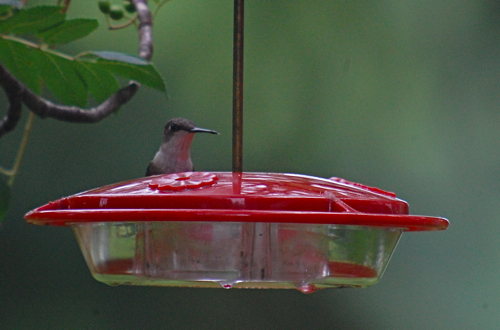 Non Birding Bill and I headed out to my favorite birding spot--Mr. Neil's yard for some hang out time and a bee check. Since my travel schedule gets insane in spring Hans has taken over keeping the feeders full as he's taking care of the yard. He does a great job, but sometimes the nectar and oriole feeders empty too fast for him to keep up. When I was walking around the feeders, a ruby-throated hummingbird flew up to my head, buzzed around then flew away. I went to the nectar feeder (we use the HummZinger)--empty. I made some nectar and less then a minute from stepping away a hummingbird flew down. I love how hummingbirds figure out how to get our attention when a food source is depleted. I've known hummingbirds to flutter in front of windows when a feeder is empty too. Heck, Lorraine said they had a hummer in the house last week...maybe the feeder was empty then?
Non Birding Bill and I headed out to my favorite birding spot--Mr. Neil's yard for some hang out time and a bee check. Since my travel schedule gets insane in spring Hans has taken over keeping the feeders full as he's taking care of the yard. He does a great job, but sometimes the nectar and oriole feeders empty too fast for him to keep up. When I was walking around the feeders, a ruby-throated hummingbird flew up to my head, buzzed around then flew away. I went to the nectar feeder (we use the HummZinger)--empty. I made some nectar and less then a minute from stepping away a hummingbird flew down. I love how hummingbirds figure out how to get our attention when a food source is depleted. I've known hummingbirds to flutter in front of windows when a feeder is empty too. Heck, Lorraine said they had a hummer in the house last week...maybe the feeder was empty then?
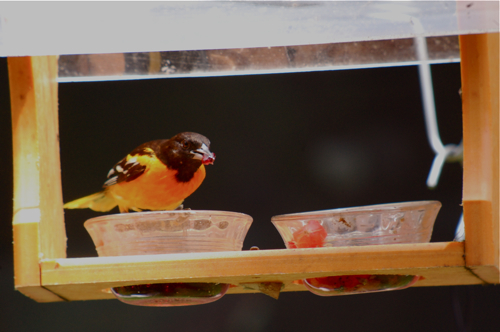
Mr. Neil's cherry tree is bursting with cherries once again and unlike last year, NBB and I managed to get out and pick some cherries before the birds raided the tart fruit. I noticed the orioles were going for the fruit and I refilled our grape jelly feeder. Orioles tend to ignore the jelly feeder in June when bugs were out, but I figured if they were eating cherries, they would eat grape jelly. I filled one cup with jelly and the other cup with cherries from the tree. As soon as I put the feeder out, the oriole went from the cherries down to our feeder...and totally ignored the cherry dish and went right for the grape jelly. The best part was that he flew off and a few moments later returned with a female.
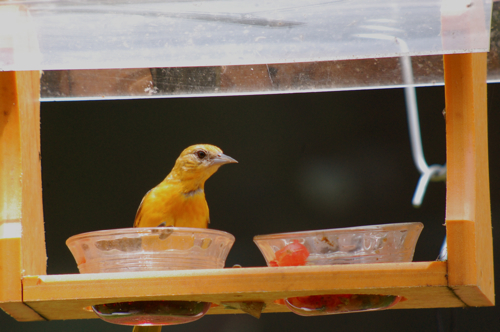
She also chose the grape jelly over the cherries. That's fine, more cherries for us! I was glad to see the orioles, I've been so preoccupied with surveys and work that I did not get a chance to really enjoy orioles at the feeder in May. Incidentally, we took our portion of the cherries (still leaving an ample supply for the birds on the upper parts of the cherry tree) and made a tart cherry crumble. Many people know Mr. Neil for his writing and general Neilness but he has mad skillz in the kitchen, I've learned some of my best cooking from him.
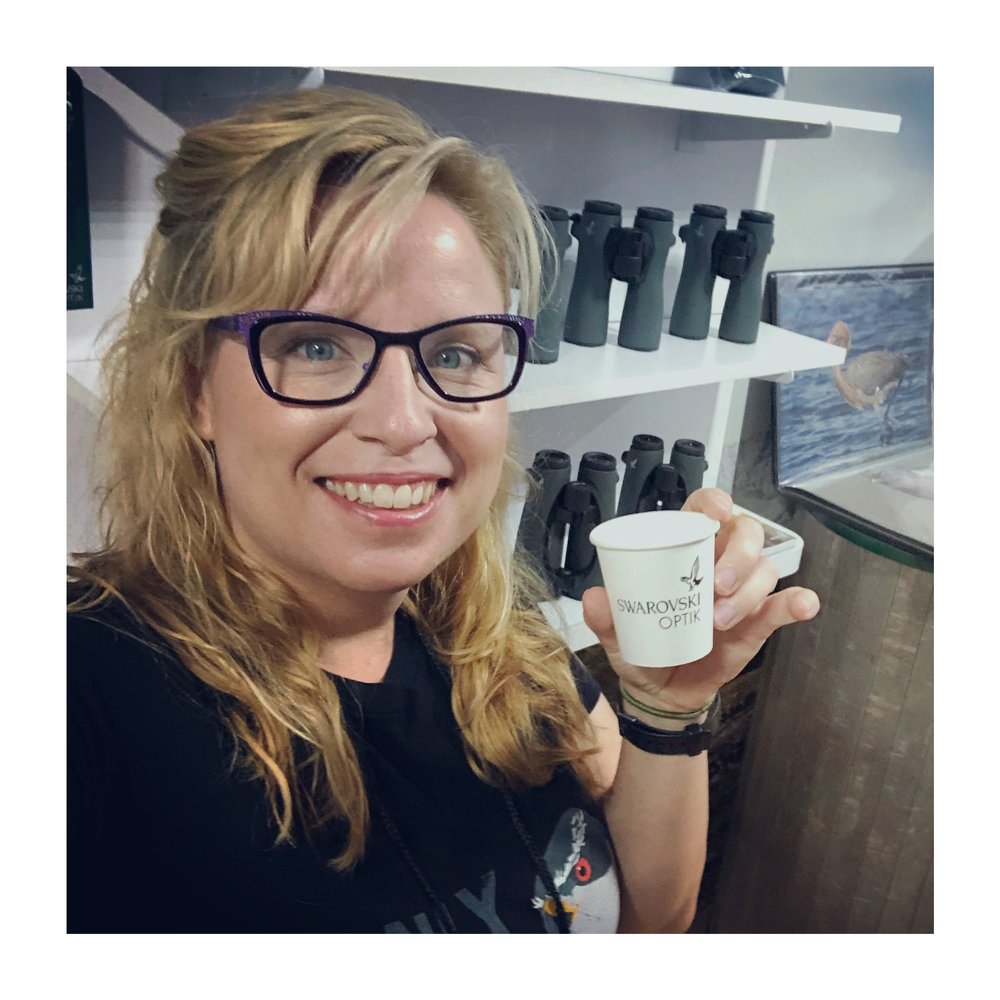
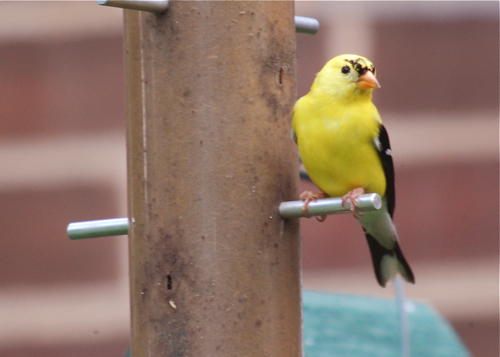
 As part of my duties as a park ranger, we go out and rove in the park. Basically, we tote around a back pack with park info and you're on hand to answer questions--it's fun, it's a bit like improv. I like to take my scope for birding of course, but it gives me a chance to explore more areas of the park that I otherwise wouldn't visit. One is Lock and Dam 1. On Friday, we did a canoe paddle through the lock (you really haven't experienced the Mississippi until you've taken a canoe or kayak through a lock and dam--to be tiny in something so big is amazing). It was fun Saturday morning to look down on it knowing the day before I had been right in it.
As part of my duties as a park ranger, we go out and rove in the park. Basically, we tote around a back pack with park info and you're on hand to answer questions--it's fun, it's a bit like improv. I like to take my scope for birding of course, but it gives me a chance to explore more areas of the park that I otherwise wouldn't visit. One is Lock and Dam 1. On Friday, we did a canoe paddle through the lock (you really haven't experienced the Mississippi until you've taken a canoe or kayak through a lock and dam--to be tiny in something so big is amazing). It was fun Saturday morning to look down on it knowing the day before I had been right in it.
 This is the view from the deck of the Lock and Dam 1 visitor center. You can see the peregrine nest box on the far left on the wall (note the box below the brick building). As I watched this, I noticed some flapping behind the big pipe on the right...
This is the view from the deck of the Lock and Dam 1 visitor center. You can see the peregrine nest box on the far left on the wall (note the box below the brick building). As I watched this, I noticed some flapping behind the big pipe on the right...
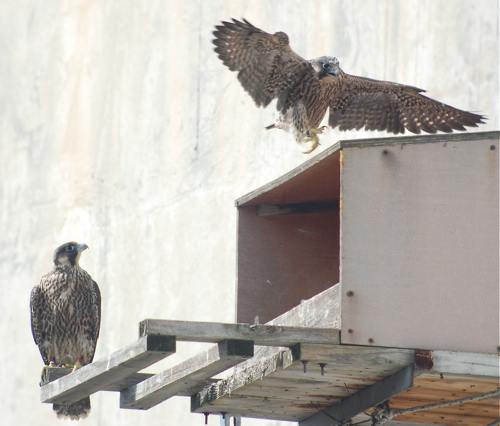 The other two continued to practice. The one on top of the box almost seemed like it was really going to get completely off the box, but stayed and screamed impatiently for one of the adults to feed it. The adults flew in once or twice with food, but no drop offs were made in the box. They want the young out of the nest so they can learn to fly. The chicks want to be fed and eventually, they will put two and two together. When the chicks are hungry enough, they will fly out towards the adults with the food.
The other two continued to practice. The one on top of the box almost seemed like it was really going to get completely off the box, but stayed and screamed impatiently for one of the adults to feed it. The adults flew in once or twice with food, but no drop offs were made in the box. They want the young out of the nest so they can learn to fly. The chicks want to be fed and eventually, they will put two and two together. When the chicks are hungry enough, they will fly out towards the adults with the food.






 I waded to the infamous intersection that has a tendency to flood--it exceeded my expectations. As I took this photo to show the water flooding 32nd and and Aldric and seeping into a neighbor's yard, I felt the water go from my toes to my mid-calf. It was the first time I experienced how quickly a flash flood hits and why you see people stuck in trees or floating cars unawares--it does happen so fast. Being a short woman around water rising quickly, I knew I needed to move. Since the police were guiding traffic to avoid this intersection from Lyndale, I dashed towards 31st to warn people away.
I waded to the infamous intersection that has a tendency to flood--it exceeded my expectations. As I took this photo to show the water flooding 32nd and and Aldric and seeping into a neighbor's yard, I felt the water go from my toes to my mid-calf. It was the first time I experienced how quickly a flash flood hits and why you see people stuck in trees or floating cars unawares--it does happen so fast. Being a short woman around water rising quickly, I knew I needed to move. Since the police were guiding traffic to avoid this intersection from Lyndale, I dashed towards 31st to warn people away.



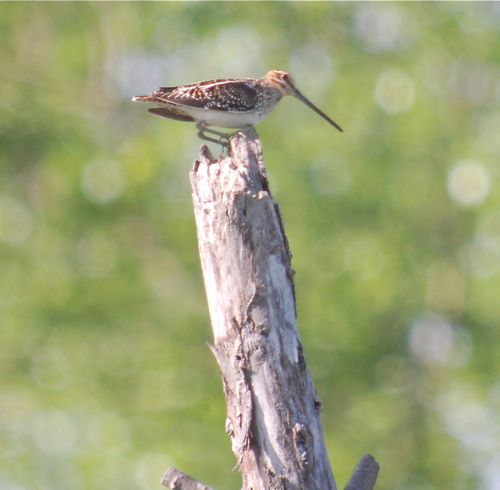
 Just a heads up that right now is an excellent time for peregrine falcon viewing at
Just a heads up that right now is an excellent time for peregrine falcon viewing at 




 And here is the front of the flycatcher--note they do have some yellow on the belly, but nothing like what we see in Carrol's photo. I thought the photo was a perfect time to talk about an AWESOME book that came out this spring.
And here is the front of the flycatcher--note they do have some yellow on the belly, but nothing like what we see in Carrol's photo. I thought the photo was a perfect time to talk about an AWESOME book that came out this spring.
